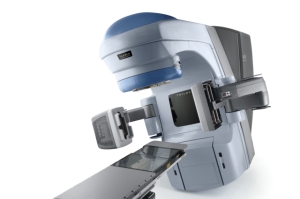DOTmed Industry Sector Report: Linear Accelerators and Simulators
by Barbara Kram, Editor | November 19, 2008

The precision of
Varian's Trilogy allows
you to spare healthy
tissues to an extent
that was unimaginable
only a few years ago.
Varian's Trilogy allows
you to spare healthy
tissues to an extent
that was unimaginable
only a few years ago.
Note: This report originally appeared in the October 2008 edition of DOTmed Business News. A list of registered users that provide sales & service can be found at the end.
Death rates from cancer in the United States have decreased by 18.4 percent among men and by 10.5 percent among women since the early 1990s. That is more than half a million cancer deaths averted in the United States. We all know the benefit of early detection, but that's only half the story. Effective treatments, including radiation therapy, are the reason that the U.S. is home to 12 million cancer survivors. As the population ages, the demand for cancer treatment technologies is expected to increase.
"Cancer incidence is growing and we think that the overall [radiation oncology] market is growing at a low double-digit rate, so the market is very healthy. There is certainly room for three or four strong competitors in the marketplace," observed Fred Robertson, CEO, TomoTherapy Incorporated, Madison, WI. The company pioneered CT image guided radiation therapy (IGRT).



The U.S. market for linear accelerators is approaching $2 billion, according to DOTmed estimates. In addition to TomoTherapy, other OEMs include market leader Varian, along with Elekta and Siemens. The manufacturers are driving major trends including IGRT and intensity modulated radiation therapy (IMRT). The result is more precise and effective treatment achieved through advancements in imaging, treatment planning/simulation and delivery.
It's no wonder that the linear accelerator is being used in specialties that might have opted for traditional surgery in the past.
Simulators and Accessories Make the Difference
A broad ballpark estimate for the cost of a new linear accelerator is from $1.5 million for a typical configuration to about $3 million for an advanced system. It's important to remember that the linear accelerator itself is just a radiation machine for fractionated radiation therapy and radiosurgery. It's the accessories that enable advanced treatment approaches. For instance, ancillary imaging devices and multi-leaf collimators enable IGRT and IMRT.
Death rates from cancer in the United States have decreased by 18.4 percent among men and by 10.5 percent among women since the early 1990s. That is more than half a million cancer deaths averted in the United States. We all know the benefit of early detection, but that's only half the story. Effective treatments, including radiation therapy, are the reason that the U.S. is home to 12 million cancer survivors. As the population ages, the demand for cancer treatment technologies is expected to increase.
"Cancer incidence is growing and we think that the overall [radiation oncology] market is growing at a low double-digit rate, so the market is very healthy. There is certainly room for three or four strong competitors in the marketplace," observed Fred Robertson, CEO, TomoTherapy Incorporated, Madison, WI. The company pioneered CT image guided radiation therapy (IGRT).
Training and education based on your needs
Stay up to date with the latest training to fix, troubleshoot, and maintain your critical care devices. GE HealthCare offers multiple training formats to empower teams and expand knowledge, saving you time and money

The Hi·Art treatment
system's linear accelerator
is mounted to a CT
scanner-like ring gantry,
which means TomoTherapy
treatments can be delivered
from all angles
around the patient.
system's linear accelerator
is mounted to a CT
scanner-like ring gantry,
which means TomoTherapy
treatments can be delivered
from all angles
around the patient.
The U.S. market for linear accelerators is approaching $2 billion, according to DOTmed estimates. In addition to TomoTherapy, other OEMs include market leader Varian, along with Elekta and Siemens. The manufacturers are driving major trends including IGRT and intensity modulated radiation therapy (IMRT). The result is more precise and effective treatment achieved through advancements in imaging, treatment planning/simulation and delivery.
It's no wonder that the linear accelerator is being used in specialties that might have opted for traditional surgery in the past.
Simulators and Accessories Make the Difference
A broad ballpark estimate for the cost of a new linear accelerator is from $1.5 million for a typical configuration to about $3 million for an advanced system. It's important to remember that the linear accelerator itself is just a radiation machine for fractionated radiation therapy and radiosurgery. It's the accessories that enable advanced treatment approaches. For instance, ancillary imaging devices and multi-leaf collimators enable IGRT and IMRT.










